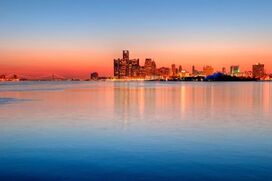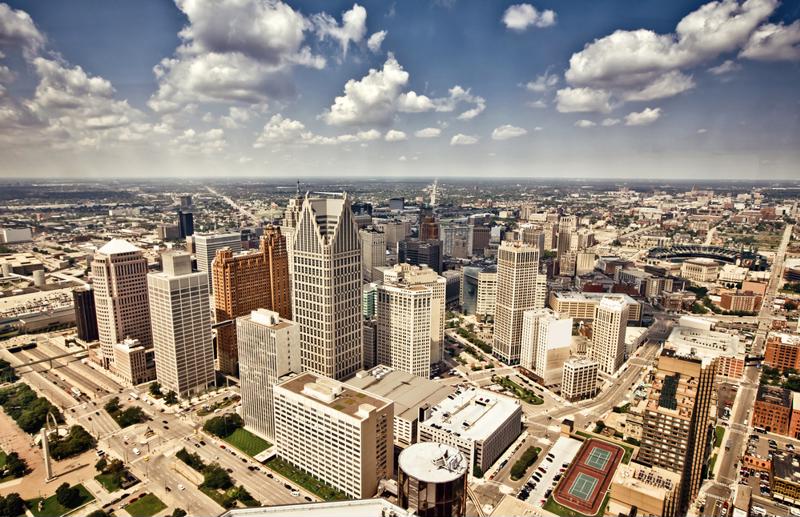
Detroit has a plan to reclaim its job market prowess
Once, Detroit was the mighty capital of manufacturing. Huge automotive companies gave the Motor City its nickname and status as a hub for American industry. Detroit was the tenth most populous U.S. city in 2010 but its luck turned over the next few years, as foreclosures, bankruptcy, urban stagnation and other factors took hold. But this isn't a story about a city that once thrived - it's a story about a city on the rise. Detroit has begun to rebound in the last two years as jobs return and the downtown area attracts valuable business.
A blueprint for success
In the face of tens of thousands of foreclosures and an infrastructure not quite prepared to take on the bustle of an emerging city, Detroit nevertheless boasts a vibrant downtown and a motivated workforce. The reason? It has reinvented itself and invested in itself. As Time pointed out, it has become "thriftier, more entrepreneurial and nimble." It is far from perfect, but its business leaders and residents are willing to take on whatever problems remain.

Let innovation play a key role in development
But it wasn't just any investment that sparked this revolution. In 2014, Detroit Mayor Mike Duggan announced the creation of an Innovation District similar to those in Boston and Atlanta, Crain's reported. The idea behind these districts is to create a walkable, accessible, urban space in which businesses exist in proximity with startups, corporations, universities, research facilities and so on. They are, according to a Brookings presentation, the next step in the progression from industrial district to research park. They occur at the intersection of economic, networking and physical assets.
"We have right now some great creative energy occurring in downtown and midtown," Duggan said in the announcement last year. "The focus of the Innovation District will be to create an anchor to support neighborhood business incubators across the city."
Rebuild the city one neighborhood at a time
With that said, Detroit still faces some growing pains. Certain aspects of the city take precedent over others, USA Today pointed out. To develop the downtown, folks on the city limits may feel neglected - for now. The plan is to take progress one area at a time and make sure there is stable footing before moving on to the next region. That's why downtown Detroit appears so healthy while the outskirts still need work.
One way the city has appeased the debt collectors has been to offer them something it has in abundance - not money, but land. That allows Detroit to save what money it does have while also promoting infrastructure growth and land development at the hands of those creditors. It's a win-win situation.
"The low cost of living in downtown Detroit is a favorable condition for business."
Bring jobs back to the city
Through the Innovation District, proper land management and other initiatives, Detroit has seen its job market improve dramatically. As of March 2015 employment was up from the previous year in every sector in Detroit with the exception of Government, according to the Bureau of Labor Statistics. Manufacturing saw the biggest growth at 4.6 percent, while Professional and Business Services grew by 2.5 percent and Financial Activities increased by 2.3 percent.
Ava Wiseman, Beacon Hill Staffing's Detroit Division Director, said demand for IT professionals is growing daily. Once enough talented workers realize Detroit is on the way up, the market should thrive.
"The last 8 years Detroit has been portrayed as the sinking ship, making it extremely difficult for us to get IT professionals to relocate here," Wiseman explained. "What they don't realize is, Detroit is making a strong come back and reinventing itself for the better. Detroit still has a lot to offer."
Savvy business owners and entrepreneurs identified the low cost of living in downtown Detroit as a favorable condition for business and decided to open up shop in the urban center. Quicken Loans founder Dan Gilbert also saw millennials flocking to city centers instead of the suburbs, according to Time.
"If I wanted to attract kids from Harvard or Georgetown," Gilbert told Time, "there was no way it was going to happen in a suburb of Detroit, where you're going to walk on asphalt 200 yards to your car in the middle of February and have no interaction with anyone in the world except who's in your building."
The ability to transport people in and out from the suburbs and city outskirts is also integral to the revitalization of the city center. Public transportation has never been a strong point for the Motor City, but there are plans in the works to develop a rail to connect the city's neighborhoods. The M-1 Rail is scheduled for completion in 2016. According to Time, a comparable initiative in Portland, Oregon yielded far more economic development than cost.
The rest of the country's perception of Detroit is changing for the better, and for good reason. These trends not only represent a path forward for the resilient city, but a blueprint for urban areas in a similar position. With the progress the Motor City has made already, don't be surprised if it's completely returned to prominence within a few short years.
This content brought to you by the Marketing Team at Beacon Hill Staffing Group.
 Back to Top
Back to Top

